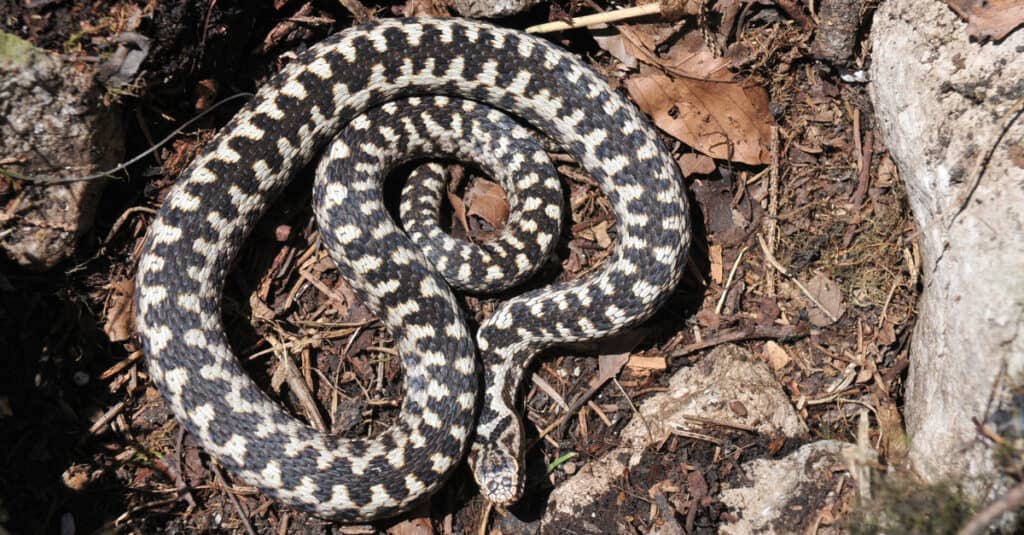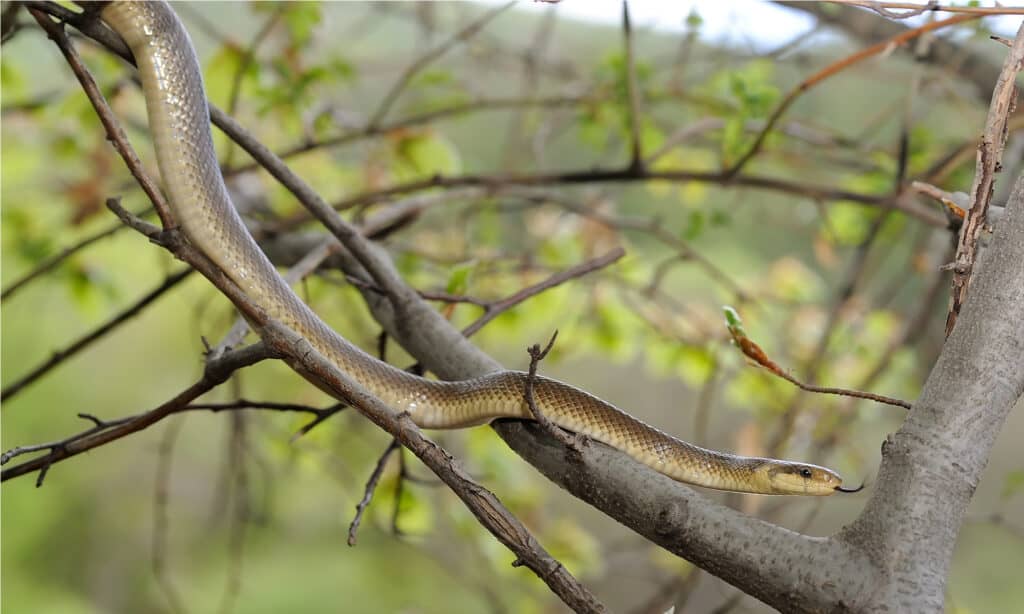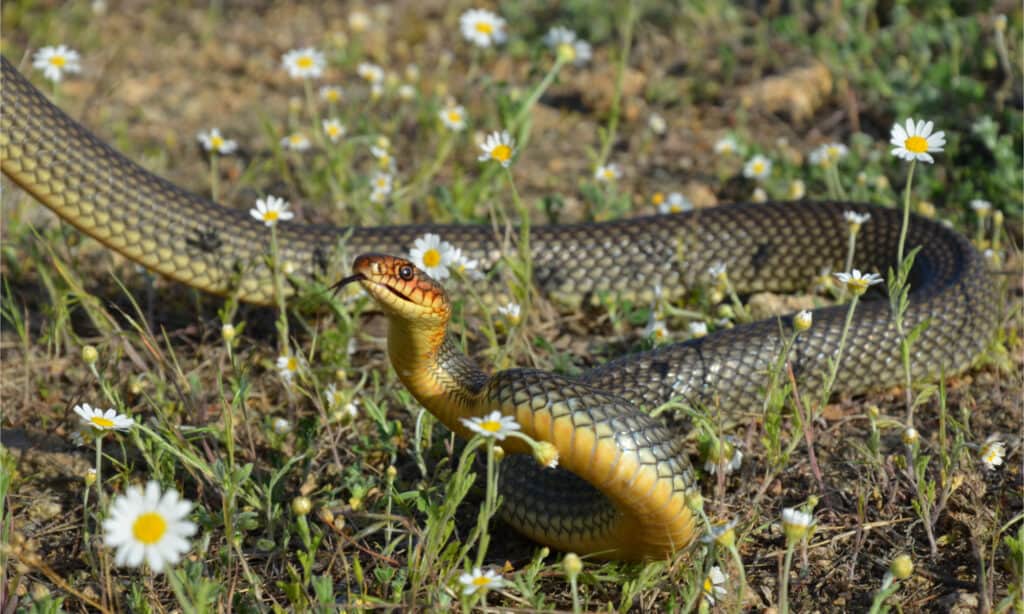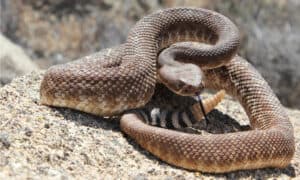Snakes have been around far longer than humans—they were slithering on the ground and in trees when dinosaurs walked the Earth. Today, there are nearly 4,000 known species of snake, with some growing to over twenty feet long. All snakes share a few key characteristics – they’re carnivores with powerful muscles instead of legs for movements. They have extremely flexible jaws, and some have venom glands or even heat-sensing organs. A few species of snake, specifically cobras and vipers, have long fangs for delivering venom.
Today, snakes live on every continent except Antarctica. They can even be found in some of the remotest places in the world. Their habitats range from sandy deserts to lush tropical rainforests. But, what snakes live in Europe, and which is the largest?
Here, we’ll take a closer look at a few of the most common species of snake in Europe, as well as where you can expect to find snakes in Europe. We’ll go over the venomous snakes of Europe, then turn our attention to the biggest snakes in Europe. We’ll compare the two contenders for Europe’s largest snake.
Snakes in Europe

Though there are snakes in Europe, they can’t be found in every country.
©/Shutterstock.com
Snakes abound in Europe, though they can’t be found in every country. Iceland and Ireland are famously snake-free, due to their cold climates and isolation. Great Britain is home to only three types of snake; the European adder, the grass snake, and the smooth snake.
There are at least five families of snakes distributed throughout the European continent, with at least 50 species, many of them in southern and eastern Europe.
Most Common Snakes in Europe
The common European adder, also known as the common European viper, is one of the most common species of snake in Europe. It lives from Great Britain to East Asia. Other species of viper, such as the Eurasian viper and the horned viper, are also common in many parts of Europe.
Other types of snake, such as the whip snake and racer snake, are also prevalent in Europe. These include the red-bellied racer, dwarf racer, and slender racer. Two of the most common whipsnake species are the Caspian whip snake and the Balkan whip snake.
Does Europe Have Venomous Snakes?

One of the most common venomous snake species in Europe is the common European viper (Vipera berus).
©/Shutterstock.com
Europe is home to around 17 species in the Viperidae family of snakes. These include the common European viper, the Haly’s pit viper, and the asp viper. Each member of this family is venomous, though only one of them, the Haly’s pit viper, has heat-sensing organs.
Bites from vipers are common, as they frequently live in urban areas or near places where human activity occurs. Luckily, viper venom is highly unlikely to cause life-threatening complications. It’s much more likely to become life-threatening in small children or health-compromised people.
Which is the Largest Snake in Europe?
Two species of snake vie for the title of “largest snake” in Europe. These are the Aesculapian snake and the Caspian whipsnake. Both snakes reach typical adult lengths of around 78 inches (6.5 feet) long.
| Aesculapian Snake | Caspian Whip Snake | |
| Size | 78 inches long | 78 inches long |
| Habitat | Forests and rocky hillsides | Meadows, grasslands, and rocky hillsides |
| Appearance | Adults are light brown with yellow undersides and round, black pupils | Adults are brown to gray with lighter undersides and thick bodies |
| Behavior | Excellent tree climbers | Readily bites in self-defense |
| Diet | Rodents, birds, bird eggs | Rodents, reptiles, birds |
Aesculapian Snake

The Aesculapian snake is non-venomous. Instead of envenomating prey, it catches and constricts prey before swallowing it whole.
©GGRIGOROV/Shutterstock.com
Aesculapian snakes can be found throughout Eastern and Central Europe, as well as in some parts of Great Britain. They’ve even been seen in Wales, though they’re not common there. They’re not considered endangered, though they are an invasive species in areas outside their native Central and Eastern Europe. Out of all snakes in Europe, the Caspian whip snake may be the best tree climber. They’re frequently seen high up on tree limbs, hunting for small mammals, reptiles, birds, and bird nests with eggs.
The Caspian whip snake generally grows to about 6.5 feet, though some even longer adults have been found. They’re oviparous, meaning that females lay eggs, rather than give birth to live young. They range in color from green-gray to brown-gray, with yellow undersides and black tongues. These snakes are eaten by a wide variety of creatures, including badgers, foxes, feral pigs, and birds of prey. When young, they’re at risk of predation by domestic cats, dogs, chickens, and even hedgehogs.
Caspian Whip Snake

The Caspian whip snake (Dolichophis caspius) does not have venom, but it is known for its short tempers.
©Valentina Moraru/Shutterstock.com
These snakes are native to Eastern Europe, the Balkans, some parts of the Mediterranean, and the Middle East. They’re not listed as endangered, though they are frequent victims of car accidents and other vehicles as they attempt to cross highways. They’re known for their quick defense, which generally includes hissing and multiple bites in quick succession. The Caspian whip snake’s diet consists primarily of small mammals, rodents, birds, reptiles, and occasionally amphibians.
These snakes grow to an average length of 6.5 feet, though large adults can grow even larger. They’re thick-bodied, with narrow heads and large, black eyes. Their coloring ranges from solid brown to gray, with pale undersides. Females are oviparous and lay between 5-15 eggs per clutch. Like the Aesculapian snake, the Caspian whip snake is non-venomous but won’t hesitate to bite when humans come too close.
The photo featured at the top of this post is © Piotr Velixar/Shutterstock.com
Discover the "Monster" Snake 5X Bigger than an Anaconda
Every day A-Z Animals sends out some of the most incredible facts in the world from our free newsletter. Want to discover the 10 most beautiful snakes in the world, a "snake island" where you're never more than 3 feet from danger, or a "monster" snake 5X larger than an anaconda? Then sign up right now and you'll start receiving our daily newsletter absolutely free.
Thank you for reading! Have some feedback for us? Contact the AZ Animals editorial team.






